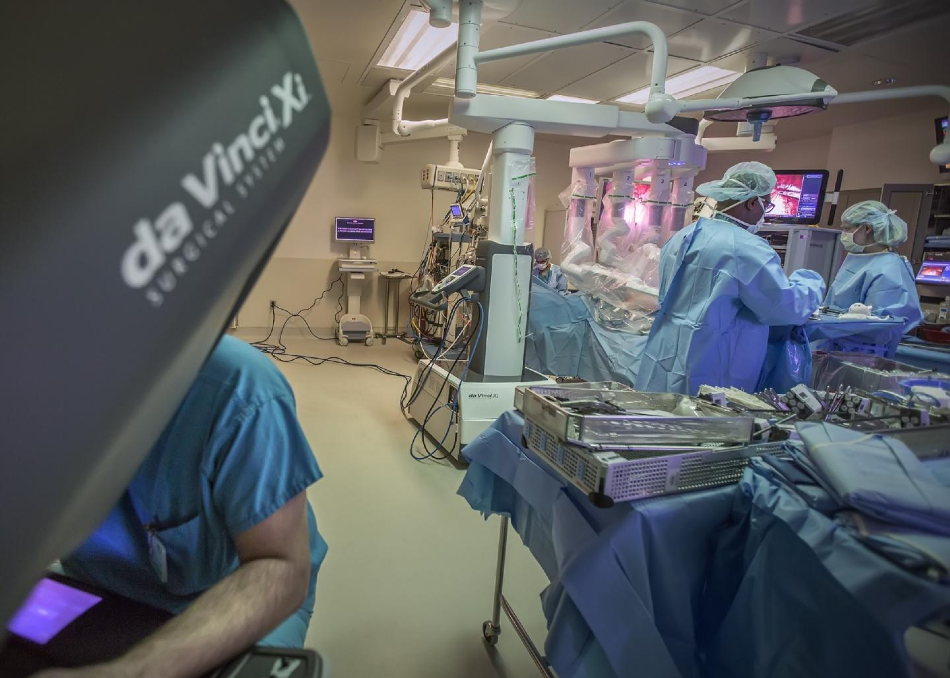Aug 21 2020
A new study performed at Cedars-Sinai Medical Center reports that robotic surgery for patients with the early stage, oropharyngeal squamous cell cancer leads to better health results, such as better long-term survival.
 A Cedars-Sinai surgical team conducts a robotic surgery. Image Credit: Cedars-Sinai.
A Cedars-Sinai surgical team conducts a robotic surgery. Image Credit: Cedars-Sinai.
The study was published recently in the JAMA Oncology journal. Oropharyngeal cancer appears at the back of the throat, including the base of the tongue and tonsils.
Transoral robotic surgery is a minimally invasive process that involves the use of a computer-optimized system to guide an endoscope—which is a flexible tube with a light and camera fixed to it—to offer high-resolution, 3D images of the back of the throat and mouth. This area is hard to reach using traditional tools.
Two robotically guided instruments serve similar to a surgeon’s arms and work around the corners to safely eliminate tumors from surrounding tissue.
This retrospective, observational study at Cedars-Sinai used data from the National Cancer Database and included 9,745 surgical patients. Of these patients, 2,694 of them had undergone transoral robotic surgery from 2010 to 2015.
From the data, the researchers identified that the overall five-year survival rate for patients with early-stage disease who has undergone robotic surgery was 84.5%, in comparison with 80.3% for patients who had undergone a non-robotic surgery, following adjustments for discrepancies in health and other characteristics of both the patient groups.
At a minimum, robotic surgery for oropharyngeal cancer patients seems safe and effective compared to what’s been the standard of care for many years.
Zachary S. Zumsteg, MD, Assistant Professor, Radiation Oncology, Cedars-Sinai Medical Center
Here, Zumsteg refers to standard surgery, chemotherapy, and radiation therapy. He is the senior and corresponding author of the study. The lead author of the study is Anthony T. Nguyen, MD, PhD, a resident in the Department of Radiation Oncology at Cedars-Sinai.
Oropharyngeal cancer is usually related to the human papilloma virus, which is thought to be behind 70% of oropharyngeal cancers in the United States, as per reports from the Centers for Disease Control and Prevention. Every year in the United States, around 3,500 new cases of HPV-associated oropharyngeal cancers are diagnosed in women and around 15,500 in men.
According to the study results, it was noted that the number of patients undergoing transoral robotic surgery for early-stage oropharyngeal cancer considerably increased from 18.3% in 2010 to 35.5% in 2015 following approval of the surgery for that cancer by the U.S. Food and Drug Administration in 2009.
Also, the number of facilities carrying out transoral robotic surgery in the same period increased by more than two times, from 6.3% to 13.9%.
The countrywide increase in transoral robotic surgery for oropharyngeal cancer in the United States inspired the investigators to evaluate if the theoretical advantages of robotic surgery for oropharyngeal cancer patients offer outcomes that are equivalent to or better than the traditional treatments for that cancer type and others.
Besides the higher overall survival rates, the team identified that robotic surgery resulted in lower rates of positive surgical margins—12.5%—in comparison with a rate of 20.3% for non-robotic surgery in patients who have oropharyngeal cancer.
Positive surgical margins relate to cancer cells that continue to be at the edge of the tissue that has been eliminated surgically. Moreover, robotic surgery was related to the reduced use of postoperative chemoradiation, at 28.6%, in comparison with 35.7% for patients who had undergone non-robotic surgery.
Our purpose in doing this study was to see how this new technology, which has never been tested in a randomized, controlled trial, has influenced patterns of treatment and outcomes since its FDA approval. There is a learning curve with any new surgical technique, and new ones don't always translate into equal or improved outcomes.
Zachary S. Zumsteg, MD, Assistant Professor, Radiation Oncology, Cedars-Sinai Medical Center
Describing the findings of the study as “hypothesis-generating,” the team believes it will promote future randomized and controlled clinical trials.
Meanwhile, it’s reassuring to our patients that their survival rate is the same if not better with robotic surgery and they have the potential for a better quality of life.
Anthony T. Nguyen, MD, PhD, Study Lead Author, Department of Radiation Oncology, Cedars-Sinai Medical Center
The research was financially supported by Cedars-Sinai Cancer.